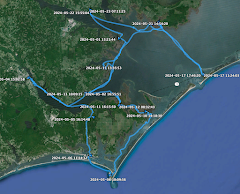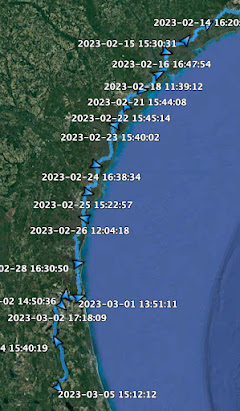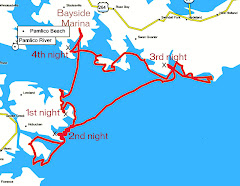I wake well-rested after a peaceful, calm night. The forecast rain never arrived. I put the boom tent away thinking I didn't need it after all. Across the water five or six small deadrises are dragging the shallows. As I tuck my gear away I notice one turns to head towards the gut where I am anchored. I wonder if he had stayed clear of SPARTINA until he saw I was awake. He puts out his net to drag just as we sail off anchor. Light or no wind wind forecast for the day, I won't be going far, and still not sure of where I will go. A granola bar and banana for breakfast, 2.3 kts across the the thin water.
Heading into the Big Thorofare Channel the wind dies. We motorsail south to the cut that will take us through the middle of the island to Tylerton. Motoring through the watermen working the grass beds I change my mind, reverse course back to the Big Thorofare, out towards Tangier Sound with a plan to be on Tangier for lunch.
A little wind, enough to sail. In the channel the deadrise Last Call motors by slowly, a friendly wave from the waterman. Once past SPARTINA he cranks up the throttle. A helpful tide and the lazy breeze carries us southeast down the Thorofare at just over 1 kt. Tangier Sound at 7:35, Last Call scraping the shallows just outside the markers.
Cool, grey, no wind. Main and jib come down, under power at just above idle speed heading south along the eastern side of Smith Island. Over the marsh I can see the rooftops of Tylerton. I'll visit there on the next trip to Tangier Sound. At 8:00 just east of the southern tip of Horse Hammock Point, only grey ahead.
Not yet 9 a.m. and there is a flutter - maybe seen, maybe felt or maybe heard, I'm not sure. I look down to see a yellow and grey bird perched on the mainsheet.
The bird, a little frazzled looking, sits still for a few minutes, then hops down the mainsheet closer to the centerboard trunk, then back up again. The bird takes flight, disappearing into the grey. A few minutes later the bird is back, perched on the mainsheet just below the boom. The bird looks around, tucks its head beneath a wing and, as far as I can tell, takes a nap. We motor south.
In the haze I think I see The Uppards, the northern end of Tangier, once a community and now just a point of the land quickly eroding away. Looking at the GPS I see I'm mistaken. It's is tiny Fishbone Island. Then I'm fooled a second time, now by Goose Island.
Finally I recognize The Uppards, and minutes later the dark shape of the trees on Port Isobel, the Chesapeake Bay Foundation-owned island just across the sand flats from Tangier. The bird takes flight, heads east then turns back west toward the island marshes. At 9:30 I refuel the outboard outside the entrance channel to Tangier and put on the docklines.
We pass Port Isobel to port then follow the channel through the crab shanties. It's crab season and deadrises come and go from the shanties. A few waves from the waterman, and I see Ooker, the island's mayor, running his skiff out to his shanty where he works shedding tanks for soft-shell crabs.
We tie up at the marina behind the deadrise Anna Parks II at 10:00. I walk up the dock to find Milton Parks, a waterman for three decades that now runs the marina, working on his golf cart (golf carts being the preferred mode of transportation on the island). I say hello, shake his hand and give him five one dollar bills to for the day-use fee of his docks. I've known Mr. Parks for a few years, he is always reluctant to take my money. He counts through the bills one by one, pulls out a dollar bill and says "I'm going to give you this one back." I thank him, tell him that is very kind. He pulls out a second dollar bill and says "I'll give you this one too." I tell him thank you, but no, I want to pay for the dock. He pushes the dollar bill up against my chests, pokes it into me with a finger. "Take it!" he says. I say ok, tell him when I get back home I'll give it to a charity in your name. He laughs.
I straighten up SPARTINA, throw away some bags of trash and grab the gas can to top it off. Walking out of the marina I pass by Mr. Parks. "See you later, George," he shouts across the yard. His tendency is to call all men "George," even when he knows their name.
It's quiet on the island. The watermen are out working their pots, the first boat of visitors isn't scheduled to arrive until early afternoon.
I top off the gas can at the fuel dock, a bunch of he locals sitting nearby talking in their island brogue. A stop at the grocery to pick up a gallon of water and some bug spray. I realize it is Monday and the two restaurants by the docks are closed. A woman tells me that Hilda Crockett's Chesapeake House should be serving lunch.
I walk the few blocks past the homes, the grocery, the church and post office, to find four ladies sitting on the porch at the Chesapeake House. They invite me inside. I've had dinners there before and I know that dinners are served family style. What I did not know is that lunches are too. Out comes the bowls of sliced beets, apple sauce, green beans, cole slaw and potato salad. Then a plate of sliced ham, a pan of fresh baked bread, plus corn pudding. They tell me crab cakes will be there soon, the clam fritters will take a bit longer. And I am the only customer in the place. I don't even begin to make a dent. The crab cakes are delicious, so are the fritters and so is everything else. But next time I am there by myself I will tell the kind ladies that two crab cakes and some cole slaw will do me just fine. There will be no need for dinner tonight.
Say goodbye to Mr. Parks and cast off at 1:00, motoring down the channel then cutting between the crab shanties and Port Isobel to anchor behind the sand spit at the south end of Tangier Island.
The clouds fall away and the cool grey day turns into a hot sunny afternoon. I nap, clean up SPARTINA, use the solar panel to charge the batteries and catch up on my sailing notes. I listen to a sports radio station out of Washington DC in the late afternoon. The program host begins talking about the weather and this huge storm he says is headed towards DC. I turn on weather radio to hear the weather service issue warning #88 for severe thunderstorms. There is a steady stream of alerts, from Maryland in the north to the James River in the south, the line of storms crossing the entire state. The storms are moving at 35-45 mph and contain winds from 40 to 70 miles an hour. It is pleasant, clear and sunny in the hook at Tangier. I wonder if the the storms will use up their energy and blow themselves out.
I haul in the anchor and move to where I can see through the clear water a big clear patch of sand. I set the anchor, with six feet of chain and the mushroom anchor, and use the outboard to back down and set the anchor in the sand. I pay out all the anchor line save five feet, put the line on the bow cleat, wrap the extra few feet around the mast and then tie that off on a deck cleat. I listen to both weather radio and the sports station. At the sports station they have told everybody to head to the basement. The program host stays behind in the studio, hoping, he says, to get some video of a tornado. He says it is pitch black in Washington. I think about going back got the marina but I can't tell exactly where the storm is, I don't want to get caught in the middle of all the crab shanties when the wind arrives. Plus I would have to cross the shallows, and it is getting dark. Better to stay where I am.
Watching the clock and listening to the radio I realize the storm will reach us just as it gets dark. I think I am well anchored but the weather service unnerves me with a series of warnings about funnel clouds and water spots. The boom tent is up, as is the mizzen, anchor is well set. But with talk of waterspouts I put on my pfd with SPOT attached and my personal locator beacon clipped on the belt. I get a waterproof duffel bag and put my cameras and notebooks inside, and attach a strobe to the duffel. The weather reports tell me that storm has reached the western shore of Chesapeake Bay and is coming out way.
The wind arrives at 8:55. First it is the cool outflow, then a series of blasts of wind, stronger wind than I have every experienced. I sit in the stern with the weather radio in one hand, the GPS in the other. All of a sudden we are making 1.5 knots and I think the anchor has broken loose. I feel sick to my stomach. But then watching the GPS I see that SPARTINA stops, holds and then heads back in the opposite direction. We are swinging at anchor. The wind howls, the boom tent shakes, the mizzen hums, pops and snaps in the wind.
I concentrate on the GPS, there's no point in listening to weather radio anymore. The gusts build, fall off, then build some more. The aft corners of the boom tent slap gainst the hull. I experiment with loosening the mizzen sheet to see if it reduces the sttess on the sail. It only seems to make it worse, so I snug up the sheet again.
The storms just seems to keep coming. There's some driving rain but mostly it is wind, we veer back and forth heeling to the gusts. It is 10:00 and the storm is as strong as when it began. I somehow convince myself, without any basis in knowledge, that the waterspouts would be on the leading edge of the storm, which has long since passed us. The anchor seems to be holding. What will be will be, I tell myself. I take off the pfd, climb into the sleeping bag, fall quickly to sleep.





























































2 comments:
beautifully written as always. What an adventure. Thank you
I watched your latest video the other day. Great stuff!
Post a Comment